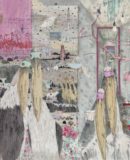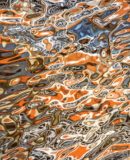The Power of Culture, The Verve of Spirit By Mara Lemanis
Mara Lemanis has worked as an archivist for Historical Preservation. She and the state archaeologist conducted research at numerous Sioux Nation sites in South Dakota, in the course of which she visited a Lakota Sweat Lodge and took part in the communal spirit of the purification ceremony. She was privileged to study the Oglala Sioux sites at Pine Ridge and Wounded Knee.
She has been a teacher and scholar of literature and film at Stanford and Yale; her essays have been selected for 20th CENTURY LITERARY CRITICISM and are included in undergraduate student textbooks in the U.S.
Recently she has worked with the IRC to assist refugees in Oakland, California.
Her father, Osvalds J. Lemanis, was an internationally renowned Latvian choreographer (The Royal Order of Vasa-Gustav V).
The Hague Convention for the Protection of Cultural Property…
THE POWER OF CULTURE, THE VERVE OF SPIRIT
Culture is the crucible that forges our visceral identity. When the UK ratified the Hague Convention on the Protection of Cultural Properties last year, it confirmed the importance of sustaining the legacy, the identity of all cultures, especially at a time of armed conflict.
Without this protection the patrimony of indigenous groups in many countries could witness the kind of disintegration that has taken place among native Indian populations all across America.
The relegation of Indian tribes to reservations ordered by the U.S. government in the late 19th century led to erosion of what was essential to their livelihood and way of life, resulting in crushing poverty among the native population. They were deprived of their shelters—the circles and hoops that served as spiritual power, artifacts they had created in trust as records of their civilization were withdrawn—their lives forced into square-shaped chambers. Such privations ushered in high crime rates among the Indian peoples along with increases in suicide, alcoholism, gang assaults, and sexual abuse.
In the aftermath of government seizure, the remains of Indian lands bear a striking resemblance to third-world countries.
In biographer John W. Neihardt’s classic narrative, BLACK ELK SPEAKS, the visionary shaman (wičháša wakȟáŋ) Black Elk movingly recounts the history of the Oglala Sioux tribe as the U.S. Government increasingly annexed native Indian territory. Black Elk describes the wrenching waste after the government conquest:
“I did not know then how much was ended. When I look back now from this high hill of my old age, I can still see the butchered women and children lying heaped and scattered all along the crooked gulch as plain as when I saw them with eyes still young. And I can see that something else died there in the bloody mud, and was buried in the blizzard. A people’s dream died there. It was a beautiful dream…the nations hoops is broken and scattered. There is no center any longer, and the sacred tree is dead.”

Black Elk’s ethnographic memoir refutes the official version of American history widespread at the time of Neihardt’s 1932 publication, which valorized western expansion and esteemed the profit-making motive as the ideal of “manifest destiny.”
The year 2016 marked the first time the destruction of cultural heritage was dealt with as a war crime. The International Criminal Court in The Hague tried and sentenced the Islamic militant, Ahmad al-Faqi al-Mahdi to nine years in prison for the cultural destruction of the historic city of Timbuktu, Mali, a Unesco World Heritage site.
Renowned through the 15th and 16th centuries as the “city of 333 saints,” Timbuktu was a prominent center of Islamic learning that included libraries with manuscripts on mathematics and astronomy. As a head of the Ansar Eddine, a movement linked to al-Queda, al-Mahdi directed Islamist fighters to use pickaxes and chisels in razing a mosque and sacred mausoleums along with many shrines and tombs of Sufi saints, and commanded the burning of approximately 4,000 ancient manuscripts.
Since the demolition of the giant Buddha statues at Bamiyan, Afghanistan, multiple artworks, museums, libraries, and places of worship have been ravaged in the Middle East and Africa. More recently the ICC has been asked to investigate the razing of the ancient site of Palmyra in Syria.
Apart from the importance of preserving a people’s heritage–its artifacts, scripts, tombs, monuments—is the existential gravity that embeds the identity of each individual within its culture. It is the embodiment of a personal sense of being. When cultural symbols are debased or pillaged, a people’s sense of unity and kinship are degraded. When that devastation accelerates, it also deepens, breaking down each individual’s sense of self.
Even when an individual considers him/her self to be a citizen of the world beyond any particular region or nation, a steep sense of loss invades the psyche. This often can feel like an amputation, a blow that severs the spirit, because one’s personal bond with one’s past has been ransacked. Stolen. A sense of personal degradation sets in. A vital part of one becomes extinguished.
When the hallmarks of our culture are destroyed, our memory will yet retain an image of their substance, but like the image we sustain of a beloved person who has died, whose fleshly presence has departed from our midst, we sharply mourn the loss.
And when we strive to kindle in the minds of our children the form, shape, and beauty of those artifacts symbolic of the culture that once linked us, encircling and protecting our endowment like a giant womb, we flounder, scanning photographs of what was lost, attempting digital replicas too inadequate to restore the original work. In vain we strive to shore some fragments against our ruins.
We are then like people who survived a tsunami, left beached among the shreds of disembodied shapes. We draw in the sand, constructing pictures for our children, for ourselves, before the surf again rises and washes out our flimsy effigies.
Beyond one’s own particular life span and the thoughts of what one leaves one’s children, what kind of legacy we offer to posterity, our thoughts speed outward—like particles birthed in a Hadron Collider–to dimensions distant from one’s daily life.
Regardless of religion, we live with intimations of unseen things–intimations of a continuity that ascends beyond our finite life to inklings of eternity.
Inklings of what may lie beyond the material world, unfolding in continuous consciousness, can be likened to the sense of an implicate order, not readily seen by the naked or the clinical eye, but that one grasps as immanent.
But here is the paradox about this implicate order: though it can generate strong imaginings about the infinite, about our spiritual nature, it relies on the material legacy of manuscripts, books, tombs, sculptures, monuments as berths in which to incubate our spirit.
Organizations like Unesco and the International Committee of the Blue Shield are forces
working to protect cultural landmarks and aid in their reconstruction. Both the ICC and The Hague Convention are striving to spare us from the kind of wasteland T. S. Eliot describes, as the narrator laments, “These fragments I have shored against my ruins.” They are determined to keep a peoples’ habitat from turning into a reservation.
–Because materials of historical legacy are invariably necessary to mark the communal spirit from where we have come, where now we are, and to limn the connotations pointing to horizons where we yet will be.
Never Seen
There lies
past sorrow
a great sigh
of beauty,
of distant
gods, majestic
countries one
has never
been or seen,
but guards
the marrow
where the mind
lies chaste,
preserves
unending
kingdoms
of the dream,
where neither
time, nor love
nor duty
pay ransom
to the
hangman’s scheme.
–Mara Lemanis
http://www.diplomatmagazine.nl/2017/08/05/hague-convention-protection-cultural-property/
http://ifthenisnow.eu/nl/artikelen/the-hague-convention-for-the-protection-of-cultural-property
Disclaimer: The views, opinions and positions expressed within this guest article are those of the author Mara Lemanis alone and do not represent those of the Marbella Marbella website. The accuracy, completeness and validity of any statements made within this article are not guaranteed. We accept no liability for any errors, omissions or representations. The copyright of this content belongs to Mara Lemanis and any liability with regards to infringement of intellectual property rights remains with the author.
Leave a Reply
The opinions expressed by individual commentators and contributors do not necessarily constitute this website's position on the particular topic.
















pingback
[…] …She has appeared on the website known as Marbella Marbella-Adelante… http://marbellamarbella.es/2017-08-07/the-power-of-culture-the-verve-of-spirit-by-mara-lemanis/ […]
http://marbellamarbella.es/2017-09-12/the-ultimate-ideology/